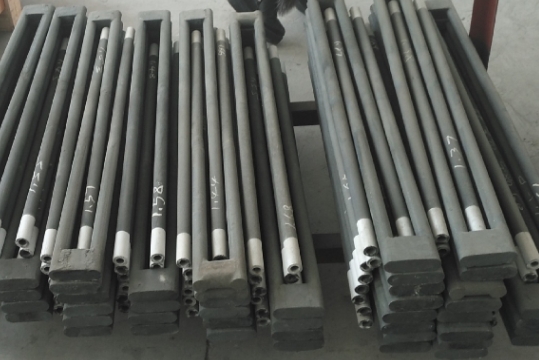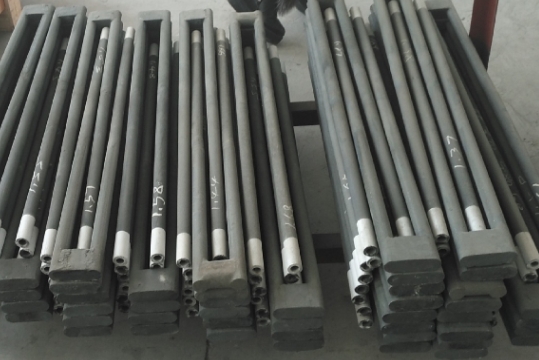Muffle furnace heating element detailed description
A. Material requirements for commonly used thermocouples in muffle furnaces
1. High temperature resistance, the temperature measurement range of the muffle furnace mainly depends on the high temperature performance of the thermoelectrode, that is to say, in the high temperature medium, the more stable the physical and chemical properties of the thermoelectrode, the temperature measurement range of the thermocouple composed of it The wider.
2. Good reproducibility-thermocouples using the same two thermoelectrode materials require their electrical and thermal performance to be comparable and stable. The high temperature horse boiling furnace can make thermocouples mass-produced and have good interchangeability;
3. High sensitivity and good linearity–The temperature difference thermoelectric potential generated by the electric couple of the high temperature horse boiling furnace is large enough and has a linear relationship with the temperature;
4. In addition to meeting the above-mentioned requirements, the high-temperature horse boiling furnace also hopes that its resistivity and temperature coefficient of resistance are as small as possible, and its price is cheap and the supply is sufficient.
B. The thermocouple for high temperature horse boiling furnace should be selected reasonably according to the requirements when using it. At present, the commonly used high-temperature horse boiling furnaces are as follows:
1. Platinum rhodium/platinum high-temperature horse boiling furnace-its index number is S, the positive electrode is an alloy of 90% platinum and 10% rhodium, and the negative electrode is pure platinum wire.
The advantage of this type of thermocouple is that it can easily prepare platinum-rhodium alloy with extremely high purity, so it is easy to replicate and has high temperature measurement accuracy. It can be used as a reference thermocouple in the range of 630.74-1064.43 ℃ in the practical temperature scale. The muffle furnace has high physical and chemical stability and is suitable for use in oxidizing and neutral atmospheres; its melting point is relatively high, so the upper limit of temperature measurement is also high. In industrial measurement, it is generally used to measure the temperature above 1000°C. The high-temperature horse boiling furnace can be used continuously for a long time under 1300°C, and the short-term temperature measurement can reach 1600°C.
The disadvantages of platinum rhodium/platinum thermocouples are that they are expensive and have low thermoelectric potential. High-temperature horse boiling furnaces will quickly be contaminated and deteriorated when used in reducing gases, metal vapors, metal oxides, silicon oxides, and sulfur oxides. In these atmospheres, a protective sleeve must be added. In addition, the thermoelectric performance of this high-temperature horse-boiler furnace is relatively non-linear. At high temperatures, its thermoelectrode will sublime, allowing rhodium molecules to penetrate into the platinum electrode to decontaminate it. Cause the thermoelectric potential to be unstable.
2. Nickel-chromium/nickel-chromium high temperature horse boiling furnace-its index number is K, the positive electrode component is 9-10% chromium, 0.4% silicon, the rest is nickel, the negative electrode component is 2.5-3% silicon, <0.6% chromium, the rest For nickel.
The advantage of this type of muffle furnace is that it has strong oxidation resistance and corrosion resistance, other scientific stability, large thermoelectric potential, and good linear relationship between thermoelectric potential and temperature. Its thermoelectrode material is cheap and high temperature. The horse boiling furnace can be used continuously for a long time under 1000℃, and the short-term temperature measurement can reach 1300℃.
The disadvantage of nickel-chromium/nickel-silicon thermocouples is that they are easily corroded at temperatures above 500°C and in reducing media, muffle furnaces and when used in sulfur and chemical atmospheres. Therefore, they must be used when working in these atmospheres. With a protective sleeve, the temperature measurement accuracy of it is also lower than that of platinum rhodium/platinum thermocouple.
3. Nickel-chromium/copper high temperature horse boiling furnace-the graduation number is E, the positive electrode nickel-chromium composition is 9-10% chromium, 0.4% silicon, and the rest is nickel; the negative electrode test copper is divided into 56% copper and 44% nickel.
The biggest advantage of the nickel-chromium/copper thermocouple is its large thermoelectric potential and low price. The disadvantage of this kind of muffle furnace is that it cannot be used to measure high temperature. The upper limit of temperature measurement is 800℃. When used for a long time, it is only limited to below 600℃. In addition, because the copper alloy is easily oxidized and deteriorated, the high temperature horse boiling furnace must be used. Install a protective sleeve.
4. Platinum-rhodium 30/platinum-rhodium muffle furnace—referred to as double platinum-rhodium thermocouple, and the graduation number is B. The positive and negative electrodes of this thermocouple are both platinum and rhodium alloys. The high temperature horse boiling furnace only differs in the proportion of alloy content. The positive electrode contains 30% rhodium and the negative electrode contains 6% rhodium. The dual platinum-rhodium thermocouple has strong anti-contamination ability. It still has good stability when the temperature is measured at 1800℃. Its temperature measurement accuracy is high, and it is suitable for oxidizing and neutral media. The muffle furnace can continuously measure the high temperature of 1400-1600℃ for a long time, and the short-term measurement can reach 1800℃.
The sensitivity of the dual platinum rhodium thermocouple is low, so it should be equipped with a high-sensitivity display instrument when in use. The temperature of the muffle furnace at room temperature has very little effect on the thermoelectric potential, so temperature compensation is generally not required during use.
5. Copper/Constantan Muffle Furnace-the graduation number is T, the positive electrode is copper, and the negative electrode is an alloy of 60% copper/40% nickel.
Muffle furnace heating element detailed description
A. Material requirements for commonly used thermocouples in muffle furnaces
1. High temperature resistance, the temperature measurement range of the muffle furnace mainly depends on the high temperature performance of the thermoelectrode, that is to say, in the high temperature medium, the more stable the physical and chemical properties of the thermoelectrode, the temperature measurement range of the thermocouple composed of it The wider.
2. Good reproducibility-thermocouples using the same two thermoelectrode materials require their electrical and thermal performance to be comparable and stable. The high temperature horse boiling furnace can make thermocouples mass-produced and have good interchangeability;
3. High sensitivity and good linearity–The temperature difference thermoelectric potential generated by the electric couple of the high temperature horse boiling furnace is large enough and has a linear relationship with the temperature;
4. In addition to meeting the above-mentioned requirements, the high-temperature horse boiling furnace also hopes that its resistivity and temperature coefficient of resistance are as small as possible, and its price is cheap and the supply is sufficient.
B. The thermocouple for high temperature horse boiling furnace should be selected reasonably according to the requirements when using it. At present, the commonly used high-temperature horse boiling furnaces are as follows:
1. Platinum rhodium/platinum high-temperature horse boiling furnace-its index number is S, the positive electrode is an alloy of 90% platinum and 10% rhodium, and the negative electrode is pure platinum wire.
The advantage of this type of thermocouple is that it can easily prepare platinum-rhodium alloy with extremely high purity, so it is easy to replicate and has high temperature measurement accuracy. It can be used as a reference thermocouple in the range of 630.74-1064.43 ℃ in the practical temperature scale. The muffle furnace has high physical and chemical stability and is suitable for use in oxidizing and neutral atmospheres; its melting point is relatively high, so the upper limit of temperature measurement is also high. In industrial measurement, it is generally used to measure the temperature above 1000°C. The high-temperature horse boiling furnace can be used continuously for a long time under 1300°C, and the short-term temperature measurement can reach 1600°C.
The disadvantages of platinum rhodium/platinum thermocouples are that they are expensive and have low thermoelectric potential. High-temperature horse boiling furnaces will quickly be contaminated and deteriorated when used in reducing gases, metal vapors, metal oxides, silicon oxides, and sulfur oxides. In these atmospheres, a protective sleeve must be added. In addition, the thermoelectric performance of this high-temperature horse-boiler furnace is relatively non-linear. At high temperatures, its thermoelectrode will sublime, allowing rhodium molecules to penetrate into the platinum electrode to decontaminate it. Cause the thermoelectric potential to be unstable.
2. Nickel-chromium/nickel-chromium high temperature horse boiling furnace-its index number is K, the positive electrode component is 9-10% chromium, 0.4% silicon, the rest is nickel, the negative electrode component is 2.5-3% silicon, <0.6% chromium, the rest For nickel.
The advantage of this type of muffle furnace is that it has strong oxidation resistance and corrosion resistance, other scientific stability, large thermoelectric potential, and good linear relationship between thermoelectric potential and temperature. Its thermoelectrode material is cheap and high temperature. The horse boiling furnace can be used continuously for a long time under 1000℃, and the short-term temperature measurement can reach 1300℃.
The disadvantage of nickel-chromium/nickel-silicon thermocouples is that they are easily corroded at temperatures above 500°C and in reducing media, muffle furnaces and when used in sulfur and chemical atmospheres. Therefore, they must be used when working in these atmospheres. With a protective sleeve, the temperature measurement accuracy of it is also lower than that of platinum rhodium/platinum thermocouple.
3. Nickel-chromium/copper high temperature horse boiling furnace-the graduation number is E, the positive electrode nickel-chromium composition is 9-10% chromium, 0.4% silicon, and the rest is nickel; the negative electrode test copper is divided into 56% copper and 44% nickel.
The biggest advantage of the nickel-chromium/copper thermocouple is its large thermoelectric potential and low price. The disadvantage of this kind of muffle furnace is that it cannot be used to measure high temperature. The upper limit of temperature measurement is 800℃. When used for a long time, it is only limited to below 600℃. In addition, because the copper alloy is easily oxidized and deteriorated, the high temperature horse boiling furnace must be used. Install a protective sleeve.
4. Platinum-rhodium 30/platinum-rhodium muffle furnace—referred to as double platinum-rhodium thermocouple, and the graduation number is B. The positive and negative electrodes of this thermocouple are both platinum and rhodium alloys. The high temperature horse boiling furnace only differs in the proportion of alloy content. The positive electrode contains 30% rhodium and the negative electrode contains 6% rhodium. The dual platinum-rhodium thermocouple has strong anti-contamination ability. It still has good stability when the temperature is measured at 1800℃. Its temperature measurement accuracy is high, and it is suitable for oxidizing and neutral media. The muffle furnace can continuously measure the high temperature of 1400-1600℃ for a long time, and the short-term measurement can reach 1800℃.
The sensitivity of the dual platinum rhodium thermocouple is low, so it should be equipped with a high-sensitivity display instrument when in use. The temperature of the muffle furnace at room temperature has very little effect on the thermoelectric potential, so temperature compensation is generally not required during use.
5. Copper/Constantan Muffle Furnace-the graduation number is T, the positive electrode is copper, and the negative electrode is an alloy of 60% copper/40% nickel.

















